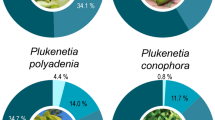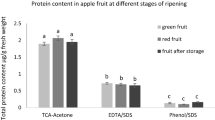Abstract
IN the course of an investigation into the distribution of water-soluble carbohydrates in seeds of the Gramineae1, it was observed that two species of grass (Lolium perenne L. and Festuca pratensis Huds.) contained in their caryopses substantial amounts of a trisaccharide which was not detected in any of the thirty other wild grasses and cereals examined. This non-reducing trisaccharide (Fig. 1, X) had a specific rotation of + 90.5° (without recrystallization), yielded equal amounts of galactose, glucose and fructose on acid hydrolysis and was readily broken down to fructose and a reducing disaccharide in the presence of invertase or very dilute acid. This ease of hydrolysis suggests that the trisaccharide resembles raffinose in containing a terminal β-fructofuranoside residue. Iodine oxidation2 indicated that the galactose residue was at the non-reducing end of the disaccharide, and electrophoretic mobility of the disaccharide in borate was intermediate between the mobilities of laminari-biose and melibiose. Movement in borate is allied to the mode of linkage of sugar residues3, disaccharides containing 1,2 or 1,4 linkages being of much lower mobility than those containing 1,3 or 1,6 linkages. The disaccharide under consideration would therefore appear to contain either a 1,3 or a 1,6 linkage. Although the electrophoretic behaviour in borate does not distinguish between α and β linkages, the high positive rotation of the trisaccharide suggests that the galactose and glucose residues are α-linked, and, since 6-glucose-α-galactoside is melibiose, it seems probable that the newly isolated disaccharide is 3-glucose-α-galactoside. The trisaccharide from Lolium perenne and Festuca pratensis is therefore tentatively described as α-D-galactopyranosyl-3-α-D-glucopyranosy 1-2- β-D- fructofuranoside.
This is a preview of subscription content, access via your institution
Access options
Subscribe to this journal
Receive 51 print issues and online access
$199.00 per year
only $3.90 per issue
Buy this article
- Purchase on Springer Link
- Instant access to full article PDF
Prices may be subject to local taxes which are calculated during checkout
Similar content being viewed by others
References
Macleod, A. M., and McCorquodale, H., New Phytol., 57, 168 (1958).
Barker, S. A., Bourne, E. J., Hewitt, C. C., and Stacey, M., J. Chem. Soc., 3734 (1955).
Foster, A. B., J. Chem. Soc., 982 (1953).
Tutin, T. G., Watsonia, 3, 317 (1956).
Stebbins, G. L., Evolution, 10, 235 (1956).
French, D., and Wild, G. M., J. Amer. Chem. Soc., 75, 2612 (1953).
Author information
Authors and Affiliations
Rights and permissions
About this article
Cite this article
MACLEOD, A., McCORQUODALE, H. Trisaccharides of Lolium and Festuca . Nature 182, 815–816 (1958). https://doi.org/10.1038/182815a0
Issue Date:
DOI: https://doi.org/10.1038/182815a0
This article is cited by
-
Cytology and genetics of forage grasses
The Botanical Review (1961)
Comments
By submitting a comment you agree to abide by our Terms and Community Guidelines. If you find something abusive or that does not comply with our terms or guidelines please flag it as inappropriate.



